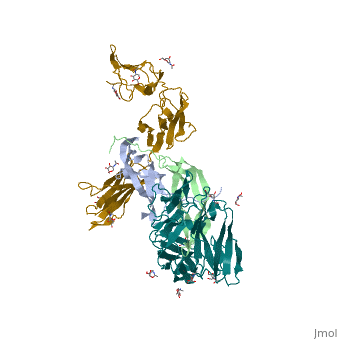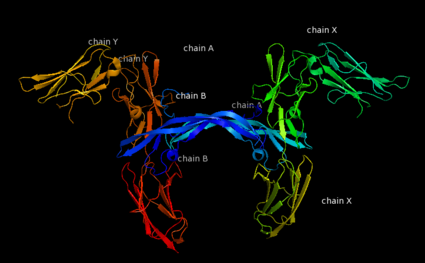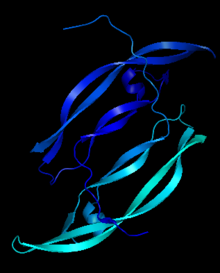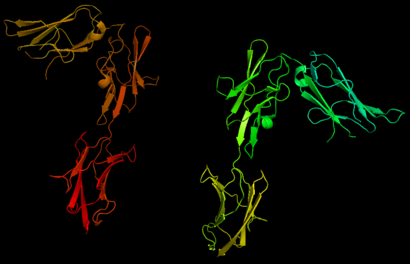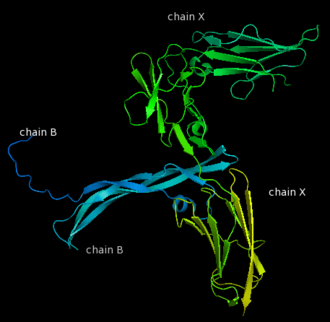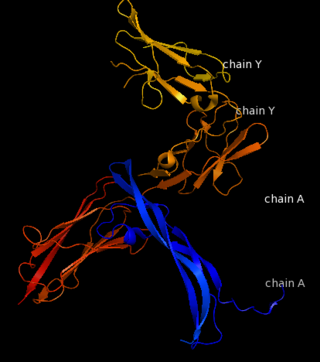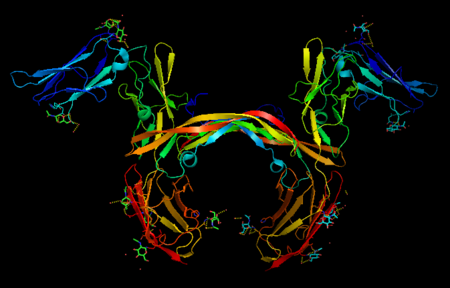Overview
Platelet-derived growth factor receptors, PDGF-R, are cell surface tyrosine kinase receptors for members of the platelet-derived growth factors (PDGFs). PDGF (Chains A and B) is a 172 amino acid sequence consisting of one alpha helix and eight beta-pleated sheets. PDGF function as disulfide-linked dimers. PDGFs have a cysteine-knot-fold growth factor domain of ∼100 amino acids involved in receptor-binding and dimerization. The synthesis and processing of PDGFs is highly regulated. There are two forms of PDGF-R, alpha and beta, which are each encoded by a different gene. Depending on which growth factor binds to the receptor, PDGF-R homodimerizes or heterodimerizes[1]. The PDGF-R is a 289 amino acid sequence consisting of two alpha helices and twenty-nine beta-pleated sheets. Together these form the PDGF-R complex[2] .
Mechanism of action
The PDGF family consists of PDGF-A, -B, -C and -D, which form either homo- or heterodimers (PDGF-AA, -AB, -BB, -CC, -DD). These four are inactive in their monomeric forms. However the PDGFs bind to the protein tyrosine kinase receptors PDGF receptor-α and -β. These two receptor isoforms dimerize upon binding of the PDGF dimer, leading to three possible receptor combinations, namely -αα, -ββ and -αβ. The extracellular region of the receptor consists of five immunoglobulin-type domains while the intracellular part is a tyrosine kinase domain. The ligand-binding sites of the receptors are located to the three first immunoglobulin type domains. PDGF-CC specifically interacts with PDGFR-αα and -αβ, but not with -ββ, and thereby resembles PDGF-AB. PDGF-DD binds to PDGFR-ββ with high affinity, and to PDGFR-αβ to a markedly lower extent and is therefore regarded as PDGFR-ββ specific. PDGF-AA binds only to PDGFR-αα, while PDGF-BB is the only PDGF that can bind all three receptor combinations with high affinity.
Dimerization is a prerequisite for the activation of the kinase. Kinase activation is visualized as tyrosine phosphorylation of the receptor molecules, which occurs between the dimerized receptor molecules (transphosphorylation). In conjunction with dimerization and kinase activation, the receptor molecules undergo conformational changes, which allow a basal kinase activity to phosphorylate a critical tyrosine residue, thereby "unlocking" the kinase, leading to full enzymatic activity directed toward other tyrosine residues in the receptor molecules as well as other substrates for the kinase. This ultimately effects gene expression and cell growth. Expression of both receptors and each of the four PDGFs is under independent control, giving the PDGF/PDGFR system a high flexibility. Different cell types vary greatly in the ratio of PDGF isoforms and PDGFRs expressed. Different external stimuli such as inflammation, embryonic development or differentiation modulate cellular receptor expression allowing binding of some PDGFs but not others. Additionally, some cells display only one of the PDGFR isoforms while other cells express both isoforms, simultaneously or separately[3] .
Tyrosine phosphorylation sites in growth factor receptors serve two major purposes: to control the state of activity of the kinase and to create binding sites for downstream signal transduction molecules, which in many cases also are substrates for the kinase. The second part of the tyrosine kinase domain in the PDGFβ receptor is phosphorylated at Tyr-857, and mutant receptors carrying phenylalanine at this position have reduced kinase activity. Tyr-857 has therefore been assigned a role in positive regulation of kinase activity.
Functionality
Platelet-derived growth factor subunits -A and -B are prototypic growth factors which have critical functions in development: regulating cell propagation, cellular differentiation, cell growth, development and many diseases including cancer[4]. PDGFs are the major components signaling mitotic cell division in connective tissues and smooth muscle cells. They also critically regulate embryonic development. PDGFα signaling targets such organs as the lung, intestine, skin, kidneys, skeleton and neuroprotective tissues. PDGFβ signaling targets hematopoiesis and blood vessel formation. While, PDGF signaling is imperative during embryonic development and early childhood, it is detrimental to adults. Some PDGF signaling in adults has lead to cancers, atherosclerosis, pulmonary fibrosis, and restenosis.
Pharmaceutical Ideas
Pharmaceutical research has been targeting inhibiting PDGF-PDGFR signaling as a potential for anti-cancer treatments. Strategies of blocking signaling at the cellular level include neutralizing antibiodies for PDGF ligands and receptors, aptamers which are oligonucleic acid or peptide molecules that bind to a specific target molecule, N-terminal processing-deficient PDGFs, and soluble receptors without the kinase domain.
See also PDGFR inhibitors.
Quiz
